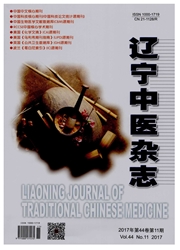

 中文摘要:
中文摘要:
目的:了解老龄肾阳虚中医证候的分布规律及目前肾阳虚的诊断情况,并对其诊断标准的优化进行探讨。方法:采用流行病学调查与专家系统评定结果相比较的方法。结果:3418例老年调查对象中肾阳虚患者922名,非肾阳虚者2496名。统计分析结果显示次症中夜尿频多、四肢发冷、脉无力、畏寒怕冷、咳喘痰清、下肢浮肿edema of lowerlimbs、苔白滑及头晕目眩在肾阳虚患者中发生率高达50%以上且均有统计学意义(P〈0.05)。专家对40个辨证因子权重排序前10位结果分别是腰膝酸软、畏寒怕冷、腰背发冷、阳痿、四肢发冷、性欲减退、阴冷、小便清长、下肢浮肿、面色黯黑。结论:老龄肾阳虚特征因子为腰膝酸软、畏寒、四肢或腰背发冷3项。常见因子为头晕目眩、咳喘痰清、下肢浮肿、夜尿频多等8项。参考因子为口淡无味、面目水肿、小便清长等9项。
 英文摘要:
英文摘要:
Objective:To get the message of the distribution characteristics and diagnosis of Kidney-Yang insufficiency syndromes with old-aging and to optimize the diagnosis criteria.Methods:Epidemiological investigation compare with the Expert-Evaluation System.Results:There are 922 Kidney-Yang insufficiency patients and 2496 are non ones in 3418 elders who be invested.Results with statistical significance(P0.05) showed that more than half the patients appeared the Minor symptoms include More urination at night、Cold extremities、Powerless pulse、Chilly、Cough and dyspnea with dilute sputum、Edema of lower limbs、White and moist music and Dizziness.Top 10 weights of the 40 dialectical factors by Expert-Evaluation System were Waist and knee weak、Chilly、Waist and back feel cold、Asynodia、Cold extremities、Hyposexuality、More and cold urine、Edema of lower limbs and Dark complexion.Conclusion:Formed factors of syndrome differentiation and diagnosis criteria of Kidney-Yang insufficiency with old-aging which contained three specific factors,eight common factors,nine reference factors.
 同期刊论文项目
同期刊论文项目
 同项目期刊论文
同项目期刊论文
 期刊信息
期刊信息
